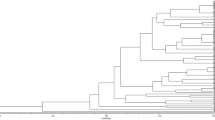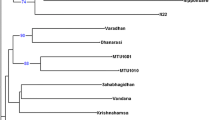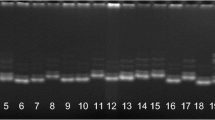Abstract
One hundred and ninety three parental lines obtained from 26 countries for an international rice molecular breeding program were evaluated using 101 well-distributed simple sequence repeat (SSR) markers. An overall genetic diversity of 0.68 and an average of 6.3 alleles per locus were revealed, indicating a high level of genetic variation in these lines. Cluster analysis of the 193 accessions showed three major groups and nine subgroups. Group I corresponded to the classical indica subspecies, whereas groups II and III belong to the japonica subspecies. Indica and japonica differentiation accounted for only 6.5% of the total variation in the entire sample and 93.5% was due to within-subspecies diversity. Differentiation among eco-geographic regions accounted for 24% of the diversity within the subspecies. Larger amounts of the eco-geographical differentiation were resolved within japonica than within indica. The largest indica-japonica differentiation based on the single locus level was detected by markers on chromosomes 9 and 12, while the smallest differentiation was detected by markers on chromosomes 4 and 8. Furthermore, genetic differences at the single-locus and two-locus levels, as well as components due to allelic and gametic differentiation, were revealed between indica and japonica and among the main geographic regions. The multilocus analysis in genetic diversity showed a higher proportion of variation caused by predominant non-random associations of different loci within and among the classified subspecies and geographic subdivisions. The results suggest that selection for eco-geographical adaptation on multilocus associations was largely responsible for the maintenance of the extensive variation in the primary gene pool of rice.

Similar content being viewed by others
References
Akagi H, Yokozeki Y, Inagaki A, Fujimura T (1996) Microsatellite DNA markers for rice chromosomes. Theor Appl Genet 93:1071–1077
Allard RW (1996) Genetic basis of the evolution of adaptedness in plants. Euphytica 92:1–11
Brown AHD, Feldman MW (1981) Population structure of multilocus associations. Proc Natl Acad Sci USA 78:5913–5915
Chang TT (1976) The origin, evolution, cultivation, dissemination and diversification of Asian and African rices. Euphytica 25:435–441
Cho YG, Ishii T, Temnykh S, Chen X, Lipovich L, McCouch SR, Park WD, Ayres N, Cartinhour S (2000) Diversity of microsatellites derived from genomic libraries and genbank sequences in rice (Oryza sativa L.). Theor Appl Genet 100:713–722
Evernson RE, Gollin D, Santaniello V (1998) Introduction and overview: agricultural values of plant genetic resources. In: Evernson RE, Gollin D, Santaniello V (eds) Agricultural values of plant genetic resources. CABI Publishing, Wallingford, UK, pp 1–29
Glaszmann JC (1987) Isozymes and classification of Asian rice varieties. Theor Appl Genet 74:21–30
Li YC, Fahima T, Beiles A, Korol AB, Nevo E (1999) Microclimatic stress and adaptive DNA differentiation in wild emmer wheat, Triticum dicoccoides. Theor Appl Genet 98:873–883
Li YC, Roder MS, Fahima T, Kirzhner VM, Beiles A, Korol AB, Nevo E (2000) Natural selection causing microsatellites divergence in wild emmer wheat at the ecologically variable microsite at Ammiad, Israel. Theor Appl Genet 100:985–999
Li Z, Rutger JN (2000) Geographic distribution and multilocus organization of isozyme variation of rice (Oryza sativa L.). Theor Appl Genet 101:379-387
Liu KD, Yang GP, Zhu SH, Zhang Q, Wang XM, Saghai Maroof MA (1996) Extraordinarily polymorphic ribosomal DNA in wild and cultivated rice. Genome 39:1109–1116
McCouch SR, Chen X, Panaud O, Temnykh S, Xu Y, Cho YG, Huang N, Ishii T, Blair M (1997) Microsatellite marker development, mapping and application in rice genetics and breeding. Plant Mol Breed 35:89–99
Nei M (1973) The analysis of gene diversity in subdivided populations. Proc Natl Acad Sci USA 70:3321–3323
Nei M, Li WH (1979) Mathematical model for studying genetic variation in terms of restriction endonucleases. Proc Natl Acad Sci USA 76:5269–5273
Ni J, Colowit PM, Mackill D (2002) Evaluation of genetic diversity in rice subspecies using microsatellite markers. Crop Sci 42: 601–607
Ohta T (1982) Linkage disequilibrium due to random genetic drift in finite subdivided populations. Proc Natl Acad Sci USA 79:1940–1944
Saghai Maroof MA, Soliman KM, Jorgensen RA, Allard RW (1984) Ribosomal DNA spacer-length polymorphisms in barley: Mendelian inheritance, chromosomal location, and population dynamics. Proc Natl Acad Sci USA 81:8014–8018
Second G (1982) Origin of the genic diversity of cultivated rice (Oryza spp.): study of polymorphisms scored at 40 isozyme loci. Jpn J Genet 57:25–75
StatSoft (1991) Statistica. StatSoft Inc, Tulsa, Oklahoma
Temnykh S, Park WD, Ayres N, Cartinhour S, Hauck N, Lipovich L, Cho YG, Ishii T, McCouch S (2000) Mapping and genome organization of microsatellite sequences in rice (Oryza sativa L.). Theor Appl Genet 100:697–712
Vaughan DA, Jackson MT (1995) The core as a guide to the whole collection. In: Hodgkin T, Brown AHD, van Hintum TJL, Morales EAV (eds) Core collections of plant genetic resources. John Wiley and Sons Inc, Chichester–New York–Brisbane–Toronto–Singapore, pp 229–239
Weir BS (1990) Genetic data analysis. Sinauer Associations, Sunderland, Massachusetts
Yang GP, Saghai Maroof MA, Xu CG, Zhang Q, Biyashev RM (1994) Comparative analysis of microsatellite DNA polymorphism in landraces and cultivars of rice. Mol Gen Genet 245:187–194
Yeh FC, Yang RC, Boyle TBJ, Ye ZH, Mao JX (1997) POPGENE, the user-friendly shareware for population genetic analysis. Molecular Biology and Biotechnology Center, University of Alberta, Canada
Zhang Q, Saghai Maroof MA, Liu TY, Shen BZ (1992) Genetic diversity and differentiation of indica and japonica rice detected by RFLP analysis. Theor Appl Genet 83:495–499
Zhu J, Gale MD, Quarrie S, Jachson MT, Bryan GJ (1998) AFLP markers for the study of rice biodiversity. Theor Appl Genet 96:602–611
Acknowledgements
We are grateful to valuable comments from Dr. Q. F. Zhang and two anonymous reviewers on the early version of this paper. We thank Dr. McCouch from Cornell University for the primer information on the SSR markers used in the study. We also thank B. Hardy for the editorial help. Financial support from the Rockefeller Foundation, BMZ of the German government, and the National Natural Science Foundation of China is greatly appreciated.
Author information
Authors and Affiliations
Corresponding author
Additional information
Communicated by Q. Zhang
S.B. Yu and W.J. Xu contributed equally to the work
Rights and permissions
About this article
Cite this article
Yu, S.B., Xu, W.J., Vijayakumar, C.H.M. et al. Molecular diversity and multilocus organization of the parental lines used in the International Rice Molecular Breeding Program. Theor Appl Genet 108, 131–140 (2003). https://doi.org/10.1007/s00122-003-1400-3
Received:
Accepted:
Published:
Issue Date:
DOI: https://doi.org/10.1007/s00122-003-1400-3




